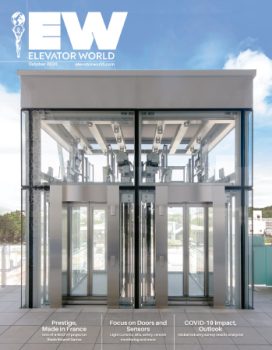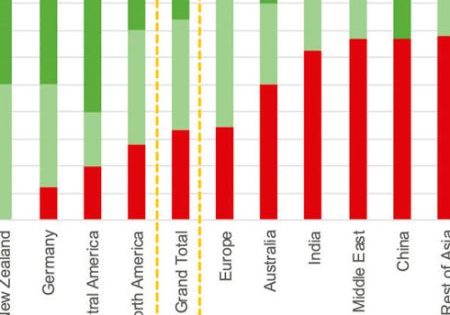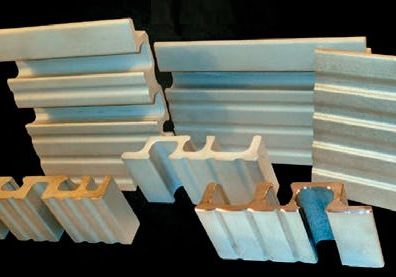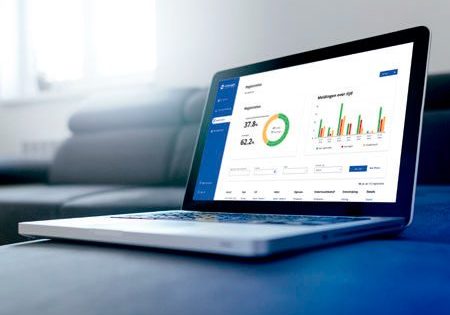Exploring predictive remote monitoring on doors and related sensors
by Dan Bryant and Marty Blackmon
Doors and Monitoring Equipment Explained
Elevator doors and the equipment for automated control come in all shapes and sizes. This article will focus on automatic horizontally sliding doors (ignoring vertically sliding doors on freight elevators) and the outside observer (outside-in) type of remote monitoring, as opposed to an OEM type of monitoring.
There are many different types of passenger elevator doors. The most prevalent include single-opening (single-slide), center-opening, two-speed and center-opening two-speed (which can be a bear to set up and maintain). There are, of course, other less-prevalent types, as well, and some companies are successful in building custom door types with automated equipment.
Automated door equipment has transitioned from simple direct-current (DC) controls with open-and-close limit switches to open-loop digital controls with limit switches, as well as closed-loop digital controls that do not need limit switches. However, some manufacturers still use them to provide redundancy, as the elevator industry maintains redundancy for safety reasons.
With so many different types of door equipment, designing the hardware and software for monitoring the doors and making sense of the data can be tough. One of the most common approaches in doing this is using accelerometers and algorithms that perform vibration analysis. In this approach, sensors such as photo sensors with reflective tape are added to help analyze the door state. Vibration analysis done well can provide telemetry for door-cycle activity, as well as reveal anomalies that can indicate poor performance and/or part breakdowns. Enough data and machine learning (ML) can provide a higher level of analytics that, one day, can determine which parts are wearing out or broken.
Currently, much research on vibration analysis is being conducted at several companies that sell remote monitoring to the elevator industry. This article will describe the differences in Datahoist’s approach to solving this puzzle.
Your Authors’ Company
Datahoist has more than 35 years of experience servicing and diagnosing elevator issues, with another 50 combined team years developing technology in various industries. Having built integrated monitoring solutions over several decades allows us to understand all the pros and cons to the different approaches in the market. We can determine the health trend of an elevator, which includes door issues using a combination of domain knowledge and Datahoist patent-pending technology. We believe that an understanding of logic signals is needed for a comprehensive understanding of the health of industrial equipment like elevator doors. Troubleshooting door equipment through the years has shown that logic circuits and switches can cause many of the door failures that lead to service visits and repairs. Door open and close limits, door safety, gate switch and interlock signals are also key to performance improvement. These signals exist in different voltage levels and types. Operating characteristics (such as active high or low) and even access to these signals vary from one type of equipment to another.
Datahoist was created to provide information to replace preventive-maintenance expertise, ultimately enabling elevator service companies to provide and customers to receive better service and longer equipment lifespans. We have firsthand experience in servicing and modernizing elevator equipment, in elevator company management and in owning elevator companies.
A combination of decline in knowledge and heightened social distancing has pushed for technology in the industrial and elevator world. This shows no sign of slowing. We must push to develop solutions to keep service technicians and customers safe.
Our custom technology enables us to learn the door patterns and describe the door behavior using highly accurate input-capturing algorithms from sensors through edge- and cloud-computing analytic systems. With this data, another level of analysis provides predictive maintenance quality data. Throughout the different levels of computing and data storage, the system provides information on door cycles, anomalies and data analysis for troubleshooting. An accelerometer, used for describing and analyzing motion on the elevator cab and drive system, also doubles in vibration analysis on the door equipment, adding to the anomaly and health analytics.
In some cases, ML is used to extract specific issues with doors. Domain expertise, in which algorithms are designed based on an expert understanding of how the equipment works, is another, older method used by several firms. Along the learning curve of remote monitoring is a level called condition-based monitoring. This is not predictive, but it is a better way of getting telemetry for maintenance. Designing and building software that describes a healthy system is a more expensive way of creating an automated alert system for notifications and reports on equipment operation. Conversely, this type of monitoring is prone to false positives, which puts additional burdens on service teams. It does, however, help with the deteriorating state of expertise in preventive maintenance being experienced by the elevator industry.
There is a future toward which the entire industry is building that will not only predict breakdowns, but will also tell the technician which part needs to be replaced and with which tools to do it.
Current Industry Dilemmas
The loss of knowledge, or “brain drain,” in skilled labor (especially in the elevator industry) is real and often the elephant in the room. The industry loses a lot of diagnostic expertise as elevator service experts retire in larger numbers every year. COVID-19 has escalated this situation, forcing companies in every market to look at new ways to keep the many elevators around the world up and running as efficiently as possible. This combination of decline in knowledge and heightened social distancing has pushed for technology in the industrial and elevator world. This shows no sign of slowing. We must push to develop solutions to keep service technicians and customers safe.
With Datahoist equipment installed, service technicians can see their elevator door and ride health trends from anywhere in the world on their phone, laptop or computer. This remote-viewing ability allows technicians to focus on elevators having door issues and get them scheduled and repaired sooner, as opposed to using a calendar-based approach to onsite visits, which leads to frequent elevator downtime.
Another side effect of COVID-19 is that many displaced workers nearing retirement might be choosing to retire now, which only compounds the brain drain problem. Newer workers do not have the same diagnostic skills as their counterparts. These valuable skills are not easily taught with the increasing workloads required of technicians today and the lack of mentoring due to the same problem of too many experts aging out of the profession.
Data and Reporting Structures for Elevators
Datahoist runs analyses that describe equipment operation for input into predictive analytics. We have found that we do not have the issue of false positives. Rather, we have data that accurately describe the health of the equipment, including the doors. In data-science circles, this low-level analysis is called “data wrangling,” among other names. Done well and combined with domain expertise, data wrangling can clean and package data for much more accurate predictive models. However, the remainder of this article will be on how to use data and reporting structures in elevator operations.
Communication to the controller is another method of data acquisition and is used by some monitor types. This is useful both to validate the analytics and to give real-time status of the equipment. Using IOmap and serial communication can add another layer of understanding by seeing if there is a difference between the outside observer equipment and the point of view of the controller. Experience has shown that accurate sensors and data handling, from outside observer equipment, give much more accurate information.
With the advancement of modern-day microcontroller units (MCUs), we now have powerful, fast, reliable units with the ability to run embedded ML at the edge (to provide an entry point into enterprise or service-provider core networks). With the latest MCUs available, Datahoist is reaching a point where it can offer an “all of the above” approach to display elevators’ health 24/7.
Installation times can vary among remote-monitoring devices and sensors. If the device is vibration-analysis-based, installation can take a few minutes. If an extra sensor such as a photo sensor is added, it can take a little longer. For example, the Datahoist SOTL5® requires five to eight discrete inputs off the top of the car to provide exact data for any elevator, versus estimating based on simple vibration analysis. Still, installation should be 2 hr or less for an experienced technician.
The Future
These different approaches come from different visions of remote monitoring. The market is big, and the technology is young and evolving. Datahoist welcomes and respects all these approaches and the people working to enhance the future for global mobility and vertical transportation. There is a future toward which the entire industry is building that will not only predict breakdowns, but will also tell the technician which part needs to be replaced and with which tools to do it. In fact, the system of the future will order the parts before the breakdown occurs. However, this is a topic for another article.
Get more of Elevator World. Sign up for our free e-newsletter.










